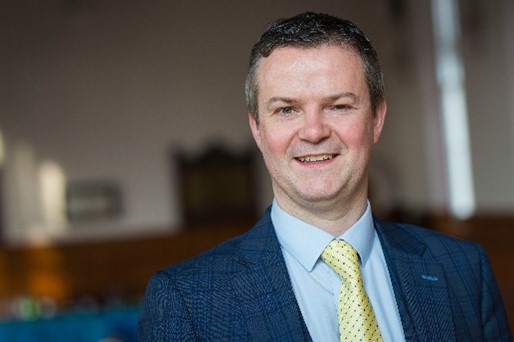
The Irish language is the podcast topic for February 2023, and Paul’s guest is Professor Malachy O’Neill, Irish language scholar and director of Regional Engagement at Ulster University. Paul and Malachy discuss all aspects of the Irish language, including its history, dialects, and status as an endangered language.
In his position at Ulster University, Professor O’Neill takes responsibility for relationships with key stakeholders including governmental agencies, councils, trusts, and other relevant authorities on behalf of the institution. He was awarded a personal chair in Irish (2020) and was provost magee campus (2016-2021) and head of the School of Irish Language and Literature (2012-2017). He has played a central role in a range of strategic initiatives for the university, including city and growth deals (UK government), Shared Island (Irish government), the inception of a School of Medicine (opened in 2021), the development of the North West Cross-border Tertiary Cluster (with FE/HE partners), and the accreditation of Derry/Strabane as a UNESCO Learning City Region.
He was awarded a National Teaching Fellowship in 2019, the highest accolade in UK Higher Education, and is a principal fellow of the Higher Education Authority. He was appointed to the Department for Communities’ Irish Language Strategy Expert Advisory Panel in 2021 was a member of the Irish Government’s Review Board of the Official Irish Language Standard (2016). He was editor of An tUltach (2008-2010). His research includes modern Irish pedagogy, the O’Neill dynasty, and Irish language theatre; and he is lead investigator (Northern Ireland) in the c.€4million Shared Island social capital research initiative with NUI Galway, University of Limerick and Atlantic Technological University. He is a board member of the Derry Chamber of Commerce and a director on the Governing Body of North West Regional College. For more information on Professor O’Neill, go here.
Malachy recently contributed his voice to the International Dialects of English Archive (IDEA). Go here to listen to him speak both English and Irish.
For information about Irish and Celtic Studies at Ulster University, go here. A similar resource can be found here. In addition, An Cailín Ciúin (The Quiet Girl) is currently making cinematic waves. And for Irish poetry, visit Lyrikline. Lastly, a wide range of short films are available online, particularly on YouTube. Yu Ming is Ainm Dom (My Name is Yu Ming), below, is a particularly illustrative look at the Irish language as perceived by both the Irish and non-Irish.
Below is a transcription of the text that Professor O’Neill reads:
Extract from An Druma Mór by Seosamh Mac Grianna (An Gúm, 1969):
Eadar sliabh agus cladach, ó Iorras go Málainn Mhór, atá Gaeltacht Thír Chonaill, mar bheadh sí ag casmairt le fiántas na farraige móire. Is iomaí fail agus cneá ar na cladaigh chéanna, is iomaí colm agus gág iontu, de thairbhe an chomhraic sin a thosaigh sula dtáinig Parthalán go hInis Samhaoir, sea, agus sula dtáinig blianta nó laetha chun an tsaoil as broinn chian cheoch na haimsire. Tá an brablach tanaí domasaí atá mar úir ann ina luí ar na creagacha is sine ar an domhan; tá grágáin go fras ann – buna na gcrann mór a mbíodh an eilit ag dul i bhfostó iontu sula gcuala Éire guth daonna riamh. Ní inseoidh neach saolta goidé mar cuireadh síol an fhraoigh atá le fáil go fóill, d’ainneoin curaíochta, síos go fíorbhéal an láin mhara. Níl seanchas lena inse féin cé a chuir an chéad spád ann. Ach is furast a dhreach a shamhailt sula ndeachthas a bhaint barr as …
English translation:
The Big Drum by Art Hughes (Ben Madigan Press, 2009):
The Gaeltacht of Tyrconnell lies between the rugged mountain and rocky shores from Urris to Malinmore, as if it were dueling with the Great Ocean. These same shores bear many wounds and scars, gores and gashes as a consequence of that conflict which began before Parthalán came to Inis Samhaoir, yes and before years or days came into the world from the distant, misty womb of time. The thin covering of mossy ground which serves as soil there lies on the oldest rocks in creation; bog oak is found in abundance – the stumps of the great trees into which the doe used to flee before Ireland ever heard a human voice. No living soul could ever tell how the first seeds of heather were planted, a plant which, in spite of tillage, is still found to the very edge of the sea. No living lore recounts who thrust the first spade there, but it is easy to imagine its countenance before it was ploughed for crops …
(Bach’s Cello Suite #1 in G Major BMV 1007 Prelude (by Ivan Dolgunov) is courtesy of Jamendo Licensing.)


